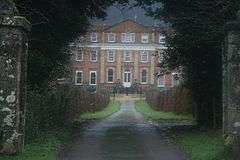Crowcombe Court
| Crowcombe Court | |
|---|---|
 | |
 Location within Somerset | |
| General information | |
| Town or city | Crowcombe |
| Country | England |
| Coordinates | 51°07′30″N 3°13′50″W / 51.1250°N 3.2305°WCoordinates: 51°07′30″N 3°13′50″W / 51.1250°N 3.2305°W |
| Completed | 1739 |
Crowcombe Court in Crowcombe, Somerset, England is a large country house dating from 1724–39. It is Grade I listed.[1]
It was built, in English regional baroque style,[2] by Thomas Parker, for Thomas Carew,[3] and finished by Nathaniel Ireson of Wincanton, after Carew found that Parker had taken old coins, found while demolishing the old house.[4] Minor alterations were carried out by Edward Middleton Barry around 1870.[1]
The house has amber coloured bricks complemented by Bath stone pilasters and frontispiece.[5] The interior includes plasterwork by Grinling Gibbons.[6] The house was described by Nikolaus Pevsner as "the finest house of its date in Somerset south of the Bath area".[7][8]
It has previously been used as a nursing home and today the Court is hired out for weddings and other functions.[3]
The new owners of the house David and Kate Kenyon purchased the property in 2011. Kate is a direct descendant of James Morrison.
The gardens and parkland are listed, Grade II, on the Register of Historic Parks and Gardens of special historic interest in England.[9]
See also
References
- 1 2 "Crowcombe Court and attached stables to west". Images of England. Retrieved 17 November 2007.
- ↑ "History of Crowcombe Court". Crowcombe Court. Retrieved 23 September 2011.
- 1 2 "Crowcombe". Quantock Online. Retrieved 17 November 2007.
- ↑ Binney, Marcus (15 August 2008). "Crowcombe Court in Somerset". Historic homes for sale. London: The Times. Retrieved 12 April 2009.
- ↑ "Crowcombe Court". Crowcombe Court. Retrieved 23 September 2011.
- ↑ Binney, Marcus (15 August 2008). "Historic homes for sale: Crowcombe Court in Somerset". The Times. London. Retrieved 23 September 2011.
- ↑ "Crowcombe Court". Historic Houses Association. Retrieved 23 September 2011.
- ↑ "Crowcombe Court". Stately-Homes. Retrieved 23 September 2011.
- ↑ "Crowcombe Court". National Heritage Register for England. Historic England. Retrieved 9 February 2016.